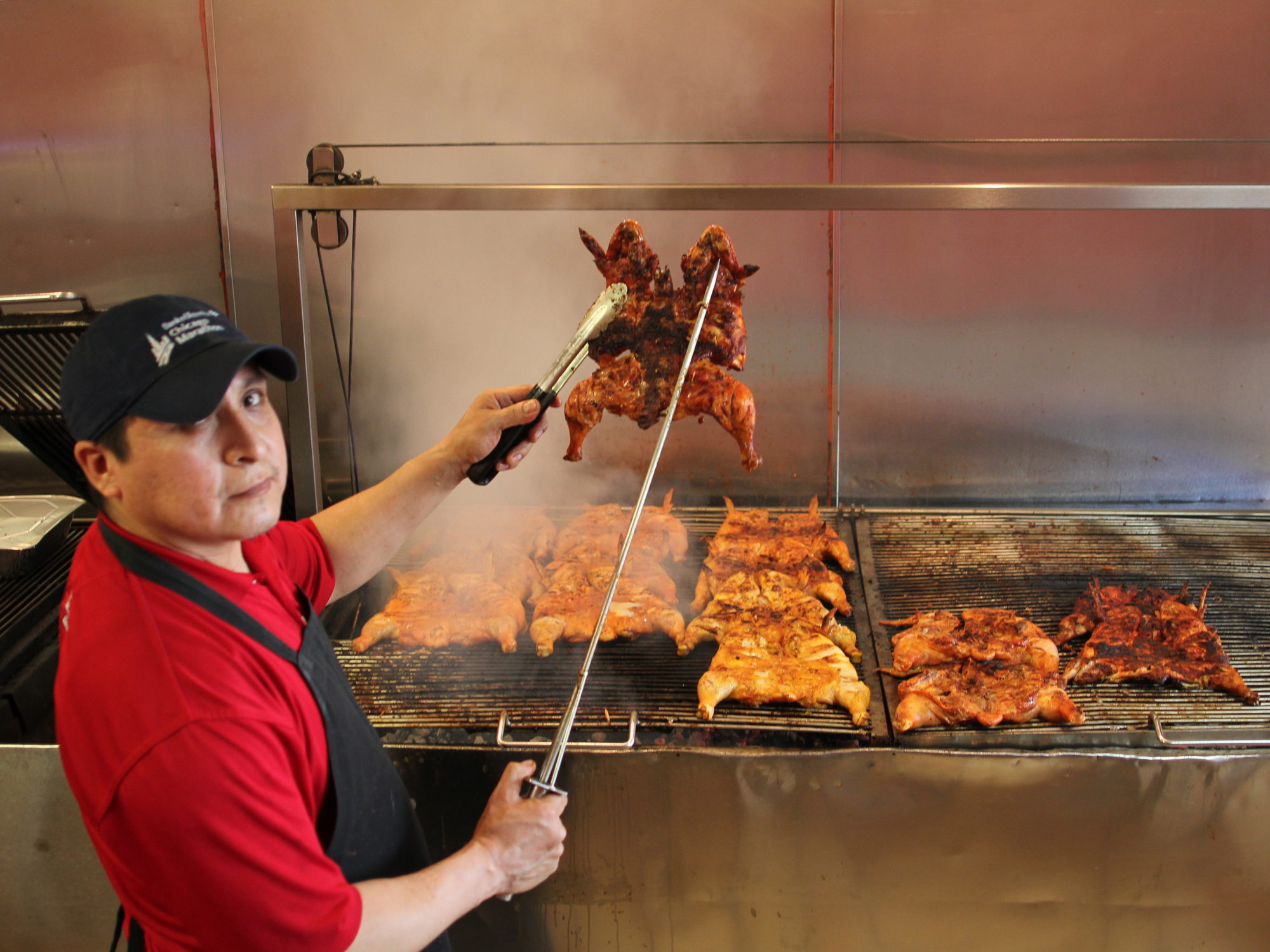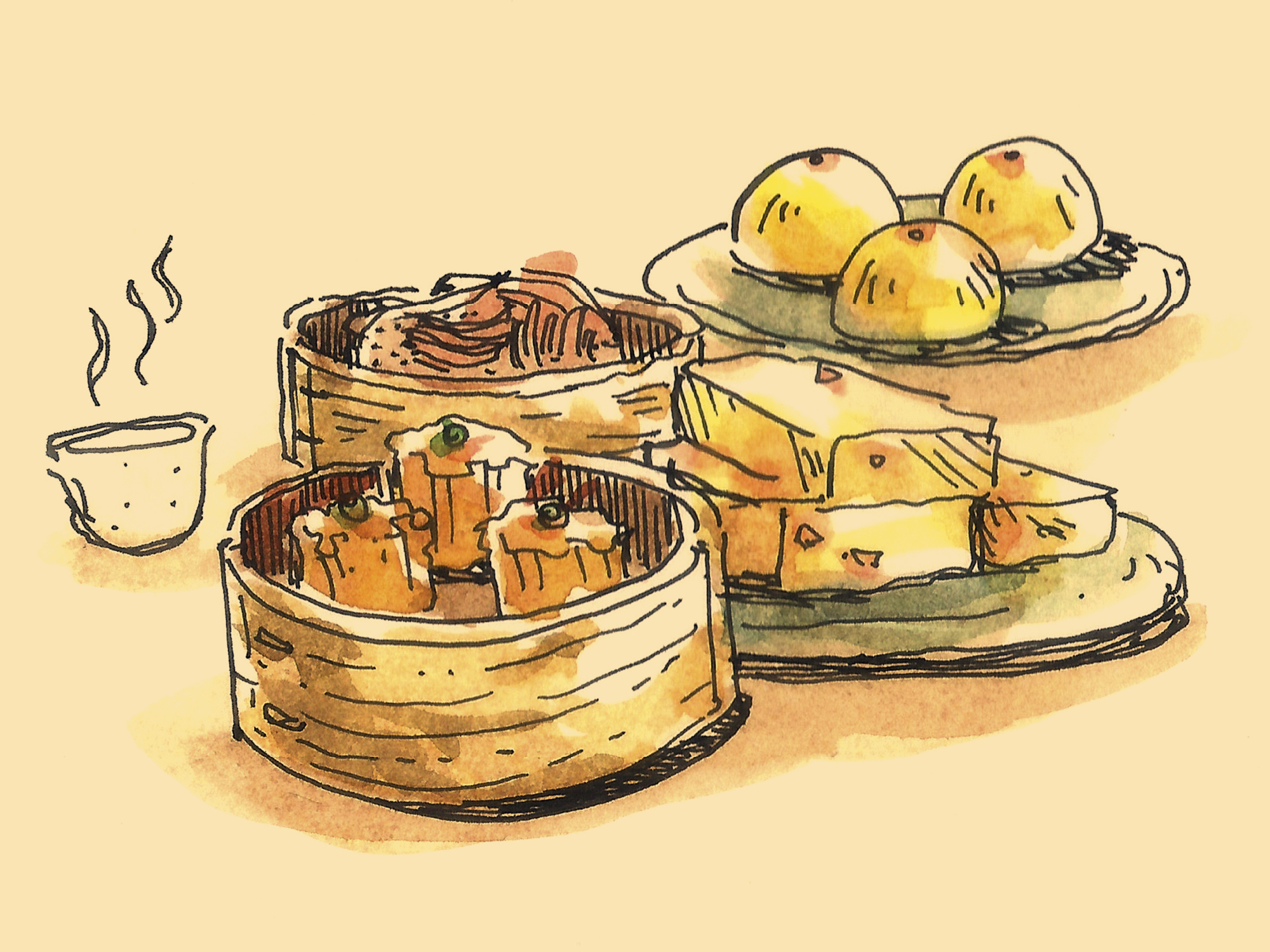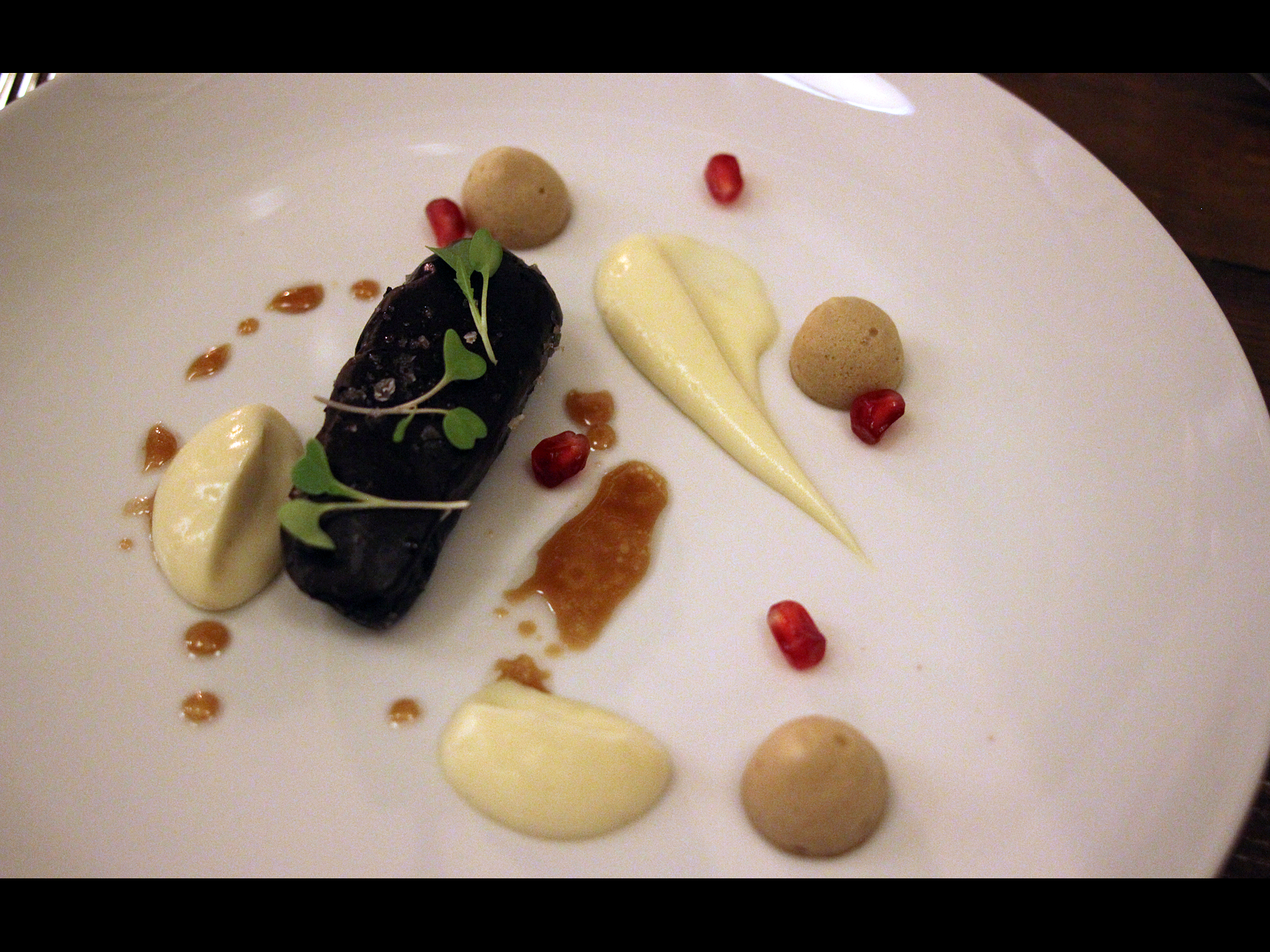Nico Osteria may be an Italian restaurant, but don’t be surprised to see French macarons served as mignardises there. Leigh Omilinsky, a 2013 Jean Banchet Awards winner for best pastry chef, took over Nico’s dessert program from Amanda Rockman at the end of June, and her French pastry roots (including five years as executive pastry chef of the French-owned Sofitel) are apparent in macarons which may be modeled after the Italian flag with red and green shells and a white coffee filling, but are unmistakably French in technique.
I caught up with her right before Thanksgiving to see how she’s adapting to a new chef, Nico’s Erling Wu-Bower, and a new pastry culture.
AMBER GIBSON: What’s the biggest difference between French and Italian pastry for you?
LEIGH OMILINSKY: Cookies aside, traditional Italian pastries are simple, straightforward and predictable. There’s tiramisu and panna cotta but your basic Italian dough doesn’t taste like much. There’s not as much butter as French. It’s olive oil, fruits, nuts, dried fruits, honey and that’s it. For our first regional menu I went straight off of some classic Italian recipe and it wasn’t doing it for me. Luckily, I get to adapt it.
Café des Architectes in the Sofitel and Nico in the Thompson seem like they’re very similar—both restaurants in hotels in the Gold Coast. Why did you decide to make the switch from one to the other?
It wasn’t a hard decision, although the idea of changing was really terrifying for me. I’m a nester and stay at jobs for a really long time. I was at Sofitel and worked with my best friends but I knew it was the right decision, the next move for me. I had actually applied for it before. It was between me and Amanda originally and she got it. It’s hard to not admire this restaurant group [One Off Hospitality] and want to be a part of a team that is so supportive of each other.
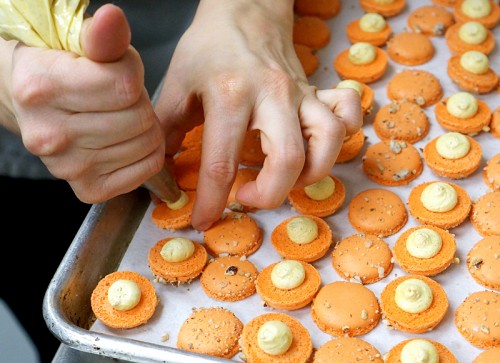
Sweet potato macarons
Sofitel was so great to me and they really made me who I am. Greg [executive chef Greg Biggers] gave me the opportunity to solidify who I was as a chef. This is like moving from high school to college or college to grad school. The biggest difference is the number of items put on a plate. We’re doing more covers here so I can’t do the same intricacies, we can’t do 450 covers where I have 30 things on a plate—and that’s also not the concept here.
Now that you’ve been here at Nico for six months, you’ve had a chance to make the menu entirely your own. What were the easiest and most difficult parts of the transition?
It was hard because it is so busy. Amanda [Rockman] and I are such good friends and we’re similar and as far as transitions go it was pretty seamless but it was hard because I had to learn all the systems and personalities. She set me up so there was no rush to change the menu for seasonality. But I wanted to make it mine and the faster I made it mine the faster I could roll with it.
I inherited a fantastic team. I cannot say enough good things about them. They are so eager and willing to learn and they bought into what I’m doing. I’m sure they were scared. They talked to me about how they were scared. Change is hard and it was scary for me too. There was some bizarre team building. We were like cats figuring each other out.
I don’t want to mess up. I’m such a perfectionist and put a weird pressure on myself. Here, I’m learning a different chef’s palate and what sells here and what’s available to me. It’s flexing different brain muscles because it’s really about stripping it down to the core of what the food is and embracing that and running with that.
What do you mean by that?
Let’s take tiramisu. I thought—OK, if I have to have a tiramisu it’s going to be the best tiramisu you’ve ever had. It’s not perfect looking, though. It looks like a blob of cream on a plate with surprises on the inside. And that was the first of this new style for me. It’s less perfect. The flavors are fairly simple and looking at it, there’s no gold leaf or microgreens on it. It is what it is and it’s delicious. In France, especially in Paris, they love the pretty shiny things and I love Paris but in Italy it’s a little more raw.
How have you adapted some of the pastries that you made at Sofitel to fit an Italian concept at Nico? For example, how are cornetti different from croissants?
We didn’t make our own croissants at the Sofitel so that whole thing is pretty new to me. We didn’t have the space for it or the labor for it. It’s so time-consuming. Very few people laminate pastry here in town. Scott [Green] at the Langham, Baker Miller, Floriole, but not many people are doing that. Sandra [Holl of Floriole] has been a sounding board for me because I don’t have huge experience with it. I got to learn and have been perfecting it here. It’s the kind of thing, like chocolate work or anything, you gotta keep doing it. I hadn’t had an outlet for it but now we do it every day here.
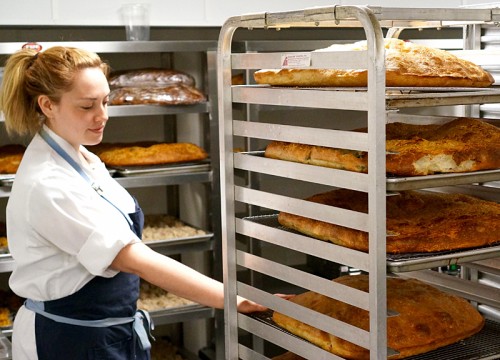
Leigh Omilinsky and her housebaked bread
Amanda left me recipes but I changed them a little. I needed them to be my own. I have a starter, his name is Stanley and he is nine years old. I got him from PQM and kept him alive at the Sofitel and I took some of him back and there’s a starter in my croissants and I mess with the ratio of butter that’s rolled into it. I turned something I was nervous about into something pretty cool.
You made some great ice cream at the Sofitel—I distinctly remember your adult sundae with candied peanuts and bourbon caramel this past spring. At Nico, I love that nearly all of your plated desserts have a gelato or sorbet component. Have you changed your ice cream recipe to a more traditional gelato?
I have a standard ice cream recipe that I definitely changed. It’s more milk-based, less fatty, a little less sweet and there are more concentrated flavors in my gelato than the ice cream I was making at Sofitel. I want you to know what you’re eating. There are egg yolks in some of them, some of them not. I’m trying to keep it super seasonal. My favorite one right now is apple butter cream cheese and I’m making my own pralines so we have Sicilian pistachio gelato and it’s yellow, not green. We candy the nuts and puree them.
There are other similarities between Italian and French. Budino is like a cremeux, with a couple tweaks. Most of it is the level of sweetness in it. Italian is less sweet although I usually don’t go super sweet to begin with.
There’s something beautifully simple about it and I’m trying to learn to love that. I love my gold leaf, I really do. But there’s something really nice about serving a plain panna cotta with just fruit. I get fancy and they stop me on it. Like you have 47,000 things on this, but you don’t really need it. Stripping down to the core of what you’re eating and concentrating on the flavors and textures. It’s all about the food. We’ll make it look good but it’s the food first.
You started a cheese program at the Sofitel with Chef Greg Biggers. You’re not making your own cheese at Nico, but are you incorporating any elements of what you learned into the pastry program here?
I miss making cheese at Sofitel. We had 150 pounds of Taleggio hanging out in the kitchen. It stank so much and was so gross, but it was the right temp and the right humidity to age it there. I miss the figuring it out part. There’s plenty to do here though.
I’m taking the idea of a composed cheese plate and my love for cheese and using Italian and Italian-style cheeses. Right now they’re all Italian and I put my spin on it. You’re not just getting a hunk of cheese and some fruit on a plate, which you can get anywhere, but there’s pastry worked into it too. It’s a choice of three but I’m working on a fourth. Gorgonzola, Robiola and Bianco Sardo—a pecorino style from Sardinia. Each is decidedly different with different accompaniments.

Sign in the pastry kitchen at Nico Osteria
You’re not afraid to step outside the bounds of Italian tradition. For example, you put mezcal in your tiramisu. From where do you draw your inspiration?
I think my process is pretty similar but I have different palates to run things by. I knew Greg’s palate and I knew what he would say when I put things in front of him. I have different people to bounce it off of now and it’s cool to learn and experiment with new products. Like Italian liqueurs—that’s a whole new world for me. So in the tiramisu, there’s the Galliano Ristretto. There’s a regional dessert right now with persimmons and I put it up for a sous chef to taste and he handed me this honey grappa that I’d never heard of before. Now I’m compressing persimmons in the honey grappa and sugar. Because we’re so true to [the Italian] concept here, there are these great resources.
When she’s not eating all the dessert in Chicago, Amber Gibson travels the world as a freelance writer for Four Seasons Magazine, Saveur, Departures, Hemispheres and American Way. You can follow her world travels on Instagram @amberyv and Twitter @ambergib.
Latest
Join the Discussion
After you comment, click Post. If you're not already logged in you will be asked to log in or register with Disqus.




